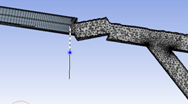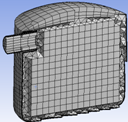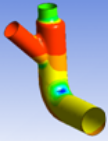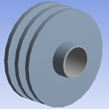Introduction to Ansys CFX
two-day courseThis course provides an introduction to conducting computational fluid dynamic simulations in Ansys CFX.
The course focuses on use of the DesignModeler and/or SpaceClaim to prepare CFD models for meshing within the Ansys Workbench meshing environment, and then pre and postprocessing with Ansys CFX.
The course devotes very little time to CFD theory and focuses on the use of the software through workshops to solve practical problems. Analysis types included in the course are generally turbulent with various functionality highlighted for each one – multiphase flow, conjugate heat transfer and fluid-structure interaction with Ansys FEA, or moving boundaries, for example.
Most workshops use neutral geometry in the form of SAT or Parasolid files for starting points. DRD encourages the students to bring a SAT or Parasolid file with them to the training (preferably a model from their workplace) for a little testing and discussion of their own problems to solve. Although most exercises will use either a SAT or Parasolid file, DRD will also demonstrate the integration between Ansys and CAD systems including associativity.
Chapter 1 - Overview of Workbench, DesignModeler, and Domain Extraction
Workshop 1a – Orientation of Workbench Interface and Sketching 
In this workshop we introduce the Ansys Workbench environment and sketching in DesignModeler and/or SpaceClaim. A small model is created from scratch so the users gain some experience with the user interface.
Workshop 1b – Extraction of Fluid Domain 
In this workshop we introduce the use of DesignModeler and SpaceClaim and the methods of creating a fluid domain from previously provided structural geometry.
Chapter 2 - Meshing a Fluid Domain for CFD Solutions
Workshop 2a – Element Types and Physical Behavior 
This workshop demonstrates how to control creation of lower order versus higher order elements and tetrahedron versus brick elements in Mechanical. It also provides students the opportunity to compare solution accuracy and computational resources for models with lower and higher elements using the Mechanical solution information object.
Workshop 2b – Creating and Combining Multiple Domain Meshes 
This workshop creates both a swept hexagonal mesh with boundary layer and a nonuniform tetrahedral mesh and combines them into a single domain for solving.
Workshop 2c – Multizone Meshing 
This workshop uses the multizone mesher to produe a hex dominant mesh and hexacore mesh with and without inflation layers.
Chapter 3 - Overview of Single Phase CFD Analysis with Introduction to Fluid-Structure Interaction
Workshop 3 – Stress Analysis of a Pump Fluid End Using Direct and Iterative Solvers
 This workshop demonstrates how to conduct a simple flow analysis in CFX and transfer the pressure boundary conditions to Mechanical for subsequent FEA analysis. Relative flow rates between the inlets are also examined.
This workshop demonstrates how to conduct a simple flow analysis in CFX and transfer the pressure boundary conditions to Mechanical for subsequent FEA analysis. Relative flow rates between the inlets are also examined.
Chapter 4 - Conjugate Heat Transfer
Workshop 4 – Conjugate Heat Transfer Simulation of Cooling Fin 
This workshop covers the creation of a conjugate heat transfer model between two different fluid domains and a tube with heat fins. Downstream flow temperatures and heat transfer coefficients for the fins are calculated.
Chapter 5 - Turbulence
Workshop 5 – Model Simplification and Flow through a Serpentine Cavity 
A serpentine cavity is extracted from a solid model, meshed with a boundary layer and the pressure drop across the model is found.
Chapter 6 - Multiphase Flow
Workshop 6 – Multiphase Flow in Sand Mixing Tank 
For this workshop the fluid domain is extracted from a tank and then various sand and water flows are applied to the inlets of the tank. Initial locations of erosion is predicted along with the rate of erosion on the tank walls.
Chapter 7 - Transient Simulations and Thermal Analysis
Workshop 7 – Transient Thermal Analysis of an Electronics Package 
For this workshop the fluid domain is extracted from a full 360 degree solid model. The heat source is surrounded by a circular heat sink to help convect away heat as 50W of energy is applied. The transient heat up is calculated.
Chapter 8 - MultiFrames of Reference, Cavitation
Workshop 8 – Free Surface Flow with Particles in an Open Channel 
A fluid domain is extracted from solid geometry for this simulation. The mesh is created and multiphase flow with air and water is defined. In addition, particulates are added to the water and the analysis is solved as transient to examine particle flow.
Chapter 9 - Free Surface Flows
Workshop 9 – Rotating Impeller with Cavitation 
The purpose of the tutorial is to model cavitation in a centrifugal pump, which involves the use of a rotation domain and the cavitation model.
Chapter 10 - Source Terms and Fan Modeling
Workshop 10 – Modeling Pressure Rise Using a Fan Curve and Filter with Source Terms 
This workshop simulates a duct with a fan and filter. The fan is not explicitly modeled but a fan curve is used instead and the filter is modeled as a porous domain.
